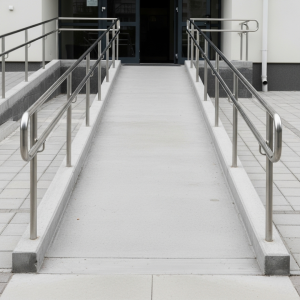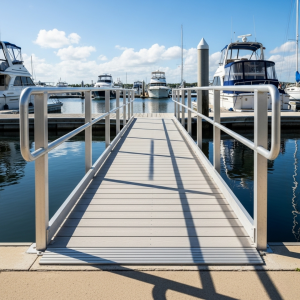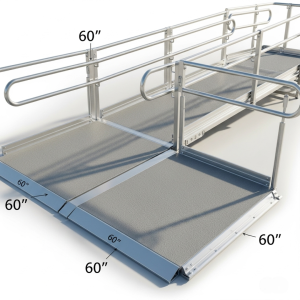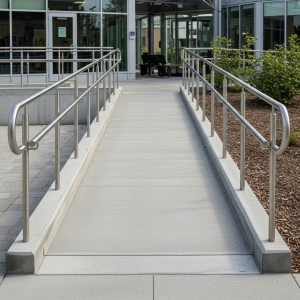Accessibility Ramp Requirements for Boats: Guidelines for Docks, Marinas, and Boarding
Accessibility in boating is more than just a convenience, it’s a necessity. Ensuring that docks, marinas, and boarding ramps meet accessibility ramp requirements allows people of all ages and abilities to enjoy the water safely and comfortably. Whether you are a marina owner, dock builder, or recreational boat operator, understanding accessibility ramp guidelines is essential for compliance, inclusivity, and safety.
In this post, we’ll cover the key accessibility ramp requirements for boats, including slope guidelines, width, materials, and best practices for docks, marinas, and boarding areas.
Why Accessibility Matters in Boating
Boating should be an inclusive experience. People with disabilities, seniors, and families with young children often need safe and convenient access points to board a boat. Accessibility ramps not only comply with the Americans with Disabilities Act (ADA) and local maritime regulations, but they also create a welcoming environment for everyone.
By installing proper ramps, marinas and docks can:
- Ensure safe boarding for all passengers.
- Prevent slips, trips, and falls.
- Expand their customer base by accommodating more visitors.
- Meet legal and regulatory requirements.
Key Accessibility Ramp Requirements
When designing or installing a boarding ramp for boats, several important guidelines should be followed to ensure accessibility and safety.
1. Ramp Slope and Gradient

The slope is one of the most critical factors in accessibility. According to ADA guidelines:
- The maximum slope for permanent ramps should be 1:12 (for every 1 inch of vertical rise, 12 inches of ramp length).
- For shorter ramps, such as temporary boarding ramps, slightly steeper slopes may be acceptable, but safety must always come first.
- Handrails are recommended for steeper ramps or ramps longer than 6 feet.
2. Ramp Width

- A minimum clear width of 36 inches (91 cm) is required to accommodate wheelchairs and mobility devices.
- Wider ramps (up to 48 inches) are often preferred in marinas to allow two-way traffic and extra space for equipment.
3. Landing Platforms

- Ramps should include level landing areas at the top and bottom.
- Landings should be at least 60 inches long, providing enough space for users to rest or maneuver.
- If the ramp changes direction, turning platforms should also be 60×60 inches minimum.
4. Surface Materials

- Non-slip surfaces are essential, especially in wet dock environments.
- Materials like treated wood, aluminum with grip tape, or composite decking with anti-slip coatings work well.
- Ramps should be designed to withstand constant exposure to water and weather conditions.
5. Handrails and Edge Protection

- Handrails should be provided on both sides for ramps with slopes greater than 1:20.
- The height should be 34 to 38 inches above the ramp surface.
- Edge protection, such as curbs or barriers at least 2 inches high, helps prevent wheels from slipping off.
Accessibility Guidelines for Docks and Marinas
Beyond ramp construction, marinas and docks must consider overall accessibility:
- Accessible parking spaces close to the ramp or dock entrance.
- Pathways and gangways that are wide, slip-resistant, and free of obstacles.
- Boarding assistance policies, such as staff support for passengers with mobility needs.
- Signage clearly marking accessible routes.
Floating docks require special attention since water levels can fluctuate. Ramps should be designed with adjustable gangways that maintain safe slopes at changing tides.
Best Practices for Boarding Accessibility
- Use portable ramps for temporary boarding situations or small boats.
- Regularly inspect and maintain ramps for wear, corrosion, or loose fittings.
- Provide lighting along ramps and docks for nighttime safety.
- Train staff in accessibility awareness and safe boarding assistance.
Conclusion
Creating ramps that meet accessibility ramp requirements is not only about meeting regulations it’s about ensuring everyone can enjoy the water equally. By following the proper guidelines for docks, marinas, and boarding areas, you provide safe, inclusive, and welcoming access to your boating facilities.
Whether you’re upgrading a private dock or managing a busy marina, proper ramp design is an investment in safety, compliance, and customer satisfaction. For high-quality dock solutions and expert support, trust Dockstop to help you make accessibility a priority.
